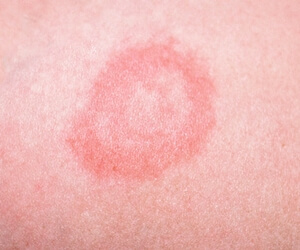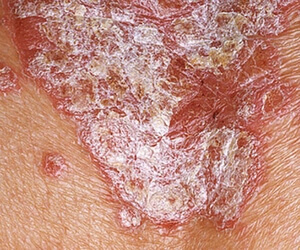Psoriasis is characterized by periods of remission and exacerbations. Skin inflammation takes place in several stages: initial, progressive, stationary, regressive. This separation will help in proper diagnosis and therapy.
Interesting to know
Psoriasis is a genetic disease. About 10% of the population has characteristic DNA disorders and only 2% of them show signs of a disturbance in the functioning of the skin.
The following factors provoke the appearance of pathology:
- strong emotional stress;
- lesions;
- alcohol abuse, smoking;
- unbalanced diet;
- infectious and other diseases;
- some drugs;
- endocrine diseases;
- predisposition to allergies;
Due to the wrong response of the immune system, which reacts to the epidermal tissue as foreign elements, the first signs of the disease appear. Consider the stages of psoriasis, its symptoms, and treatment regimens.

The initial stage of psoriasis
The first sign isthe appearance of a pimple(papules). Rounded shape, reddish or pink color. On the lower limbs, due to slow blood flow, manifestations of a bluish tinge may occur. Papular formations are small, about the size of a pinhead.
The initial stage is characterized bymany papulesthat have well-defined boundaries. Whitish scales also appear. They easily separate from the surface to the touch. Papules can merge into one, forming larger elements.
During early remission, the rash turns pale. The affected skin areas are partially discolored. In children, this stage of psoriasis is often confused with manifestations of allergies or diathesis. The rash may be accompanied by severe itching. Signs that can be used to diagnose psoriasis:
- when scraped, the surface of the plaque becomes whitish, resembles a drop of crushed stearin, the scales flake off;
- if you continue to scrape off the stain and remove the scales, a shiny red surface will appear;
- during scraping, small drops of blood appear.
Progressive stage of psoriasis
During the progressive phase of psoriasis, the following symptoms appear:
- The papules turn red, continuing to become covered with white scales. They peel off easily, under them you can see a smooth layer of reddened skin. If damaged, blood appears.
- With exacerbation, the papular elements grow, merging. They are clearly different from healthy skin areas.
- Itching that gets worse. But it passes during the transition of the process to the stationary phase. Painful, obsessive itching that interferes with sleep and daily activities. If you only scratch the lining, wounds and new plaques will appear. The appearance of new plaques at the lesion site is Koebner's syndrome. The number of manifestations of itching gradually increases, covers the body, limbs, head.
- There are no scales at the edges of the plates, they are hyperemic, which indicates the continuation of the inflammatory process.
Consequences
Psoriasis can have a negative effect on the joints (psoriatic arthritis). So there are severe pains in the joints, their deformation, if the process is left without treatment.
Stationary stage of psoriasis
The main feature of the stationary stage of psoriasis is that new elements stop appearing. Positive changes come with the right treatment.

Clinical manifestations:
- the itching disappears;
- there are no injuries (Koebner's symptom disappears);
- peeling may increase.
All commercials stop developing. If during the progressive phase the plates had a border without scales, then during the stationary phase the entire inflamed surface of the integument will peel off, acquiring a characteristic psoriatic appearance.
Scales are characteristic of the last stage of inflammation. At the beginning of the development of the pathology, the scales do not keep up with the progressive growth of the plaques and cannot completely cover them. Apseudoatrophic corollaappears in half of the cases.
Pseudo-atrophic corolla
It appears as a light border around the element, which has a structure reminiscent of rough tissue paper, consisting of a horny layer and not exceeding two millimeters in width.
Regressive stage of psoriasis
In the regressive phase of psoriasis, the psoriatic cycle ends. Salient features:
- the exacerbation process stops, the inflammation disappears;
- the plaques dissolve gradually;
- peeling stops, the elements of the rash are flattened;
- the rash turns pale pink, gradually discolored;
- papules may still remain on the arms and elbows.
No scarring or atrophy of the affected area remains. At the site of the rash, temporary hyperpigmentation or areas devoid of pigment may occur.
Remission occurs after complex therapy. The rescue period is individual. Latent disease can last for several months or even years. Flare-ups occur most often in winter, with the exception of a few forms of psoriasis.
Treatment of psoriasis in different stages
Therapy of any form of psoriasis consists of general and local treatment, methods of physiotherapy and dietary adjustments. In the initial phase of therapy, it is necessary:
- give up bad habits;
- strictly follow a therapeutic diet;
- uses ointments that contain vitamins A, D3, hormones;
- uses systemic and sedative drugs;
- undergoes ultraviolet therapy.
If the plaques are found on the head, the doctor prescribes shampoos based on tar, zinc, selenium sulfide.
All funds should be used as directed by a doctor. Long-term use of medications (especially with tar) can irritate the skin. Funds should be changed every 7 days.
Early treatment of psoriasis
The effectiveness of early treatment interventions depends on when the patient appears and begins treatment.
Early therapy in most cases helps prevent the disease from moving into a chronic form.
Experts recommend using salicylic acid ointment. It is an anti-inflammatory and antimicrobial drug that has a beneficial effect on the affected skin areas. With the help of a keratolytic effect, the ointment will clean the plaque from the keratinized parts of the integument. Naphthalene ointment helps relieve itching.
Medicines are usually prescribed:
- based on tar;
- based on solid oil;
- based on oil.
Not so long ago there were drops and oil for psoriasis. The tool is able to soothe the skin, moisturize it, prevent skin dryness and relieve swelling. The preparation contains ubiquinone, beta-carotene, beaver fat, propolis, pumpkin seed oil and other components, with the help of which the number of plaques decreases, they become less, the skin is better hydrated. It is recommended to use it in combination with other medicines and after consulting a specialist.
Treatment of progressive psoriasis
Therapy should be thorough and careful. The clinical picture is quite difficult, the treatment should be trusted only by specialists. Patients are helped by intravenous and intramuscular administration of special drugs. Sorbents help remove toxins from the body.
Manifestations remove salicylic acid ointment, emollient emulsions. They moisturize and reduce inflammation. During an exacerbation, drugs with tar in the composition or other irritating components should not be used.
Physiotherapy procedures (PUVA therapy, ultraviolet irradiation, paraffin applications) are best performed during the period of reducing inflammation. Corticosteroids and cytostatics are prescribed only when the processes are particularly complex.
Prescribe antihistamines (reduce the development of an allergic reaction), sedatives (soothing), anti-inflammatory, keratolytics (emollients), diuretics (relieve swelling, remove toxins).
Treatment of steady-state psoriasis
The patient needs a slight correction of the therapy. Shampoos with tar, emulsions with oil, calcipotriol are usually prescribed. Systemic therapy is used when the disease affects large areas of the integument. Ultraviolet irradiation and the PUVA technique are widely used.
If there is no effect, some cytotoxic drugs are prescribed. In severe cases, the patient is prescribed an immunosuppressant, cytotastic.
Treatment of psoriasis in the regressive phase
Therapy in the last stage of psoriasis should be complete, adjusted by a specialist. Therapy is gradually canceled, replaced by preventive measures. Treatment at all stages is carried out carefully, in no case should the rash be damaged.
Compliance with the strictest correction of diet and lifestyle is of particular importance. Stress can be a powerful provoking factor, significantly aggravating the condition early in the disease.
In combination with drug therapy, rashes on the hands can be treated with baths with sea salt or baby cream mixed with the powder of a series, lubricate the plaques with this mixture.
Additional therapies
A patient with psoriasis has a deficiency in vitamins, which affect the regulation of metabolic processes, have a purifying, sedative and restorative effect of the blood.
The vitamin complex should contain B vitamins, ascorbic acid, vitamin A, folic acid and others. They are prescribed internally, intramuscularly and also in droppers.
Dividing the pathology into several stages is a conditional measure that helps specialists to correctly identify one stage or another, facilitates diagnosis and treatment. It is impossible to completely get rid of psoriasis, but if all the rules of complex treatment are observed, with systematic preventive measures, the disease can be dormant for a long time and not interfere with a person's life to the maximum.
























